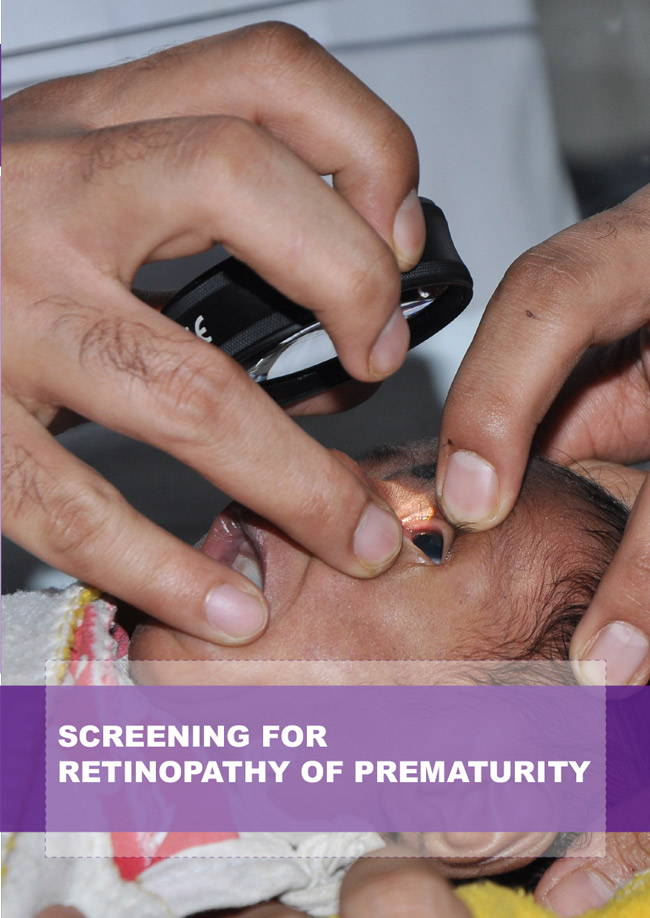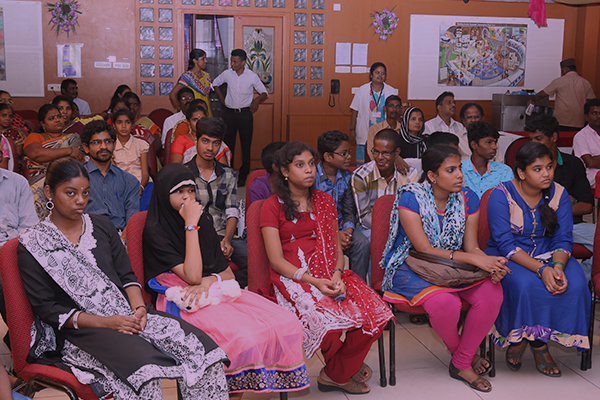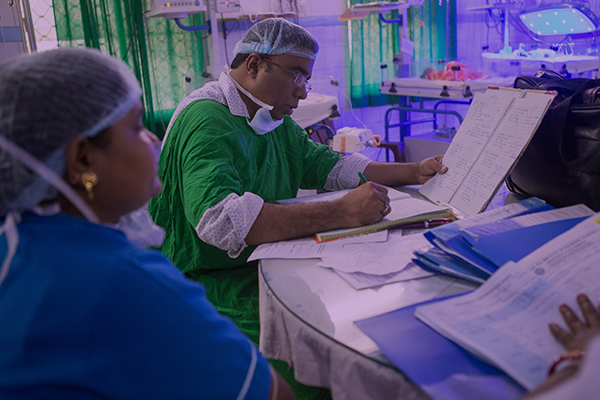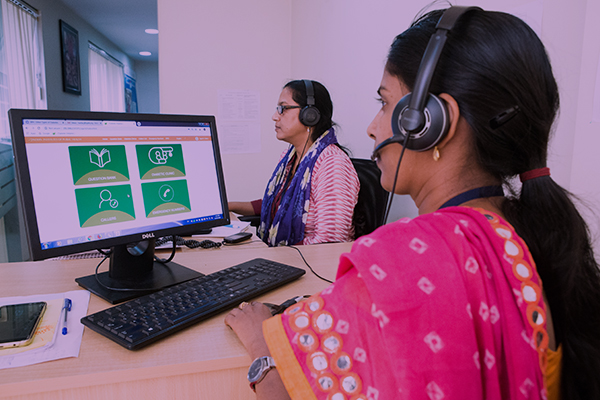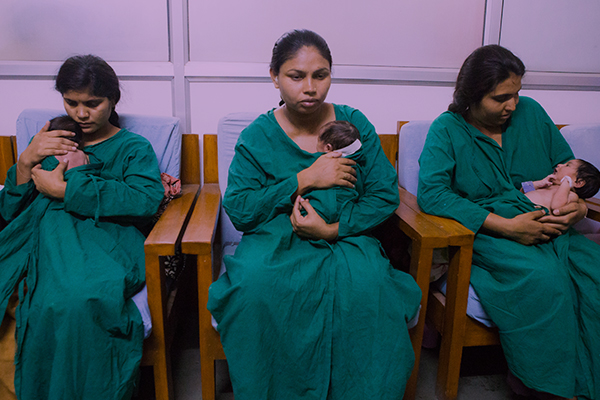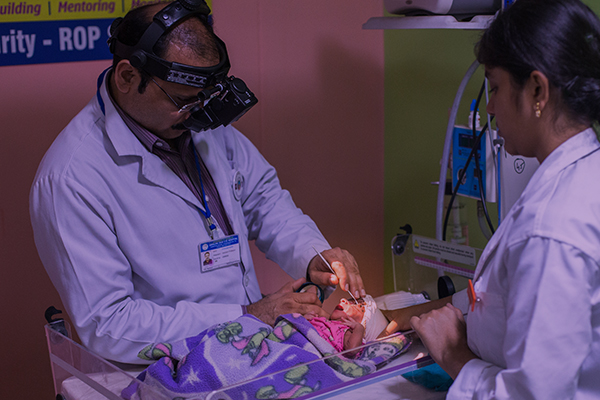What is Retinopathy of Prematurity (ROP)?
Retinopathy of prematurity (ROP), as the name suggests, can affect the eyes of infants who have been born early (preterm). The more preterm the baby, the greater the risk of ROP: ROP is unusual in babies who are only 3-4 weeks premature. Other factors which increase the risk of ROP are poorly controlled oxygen, infection, and failure to gain weight after birth, which means that preterm infants who receive suboptimal care from immediately after birth are the more likely to be affected.
Preterm infants are born with immature organs, including the light sensitive layer inside the eye, the retina, and the blood vessels which supply it. In ROP the immature blood vessels first stop growing normally, and then grow abnormally. The abnormal blood vessels can leak, and pull the retina away from the back of the eye (retinal detachment). Both eyes are usually equally affected.
Preterm babies are not born with ROP as it starts to develop a few weeks after birth.
Several different stages of ROP are described: some babies only develop the milder stages which get better without treatment. Other babies develop more severe stages which can progress rapidly to retinal detachment. Once the retina becomes detached, little can be done to restore vision, and the child becomes blind for the rest of their life.
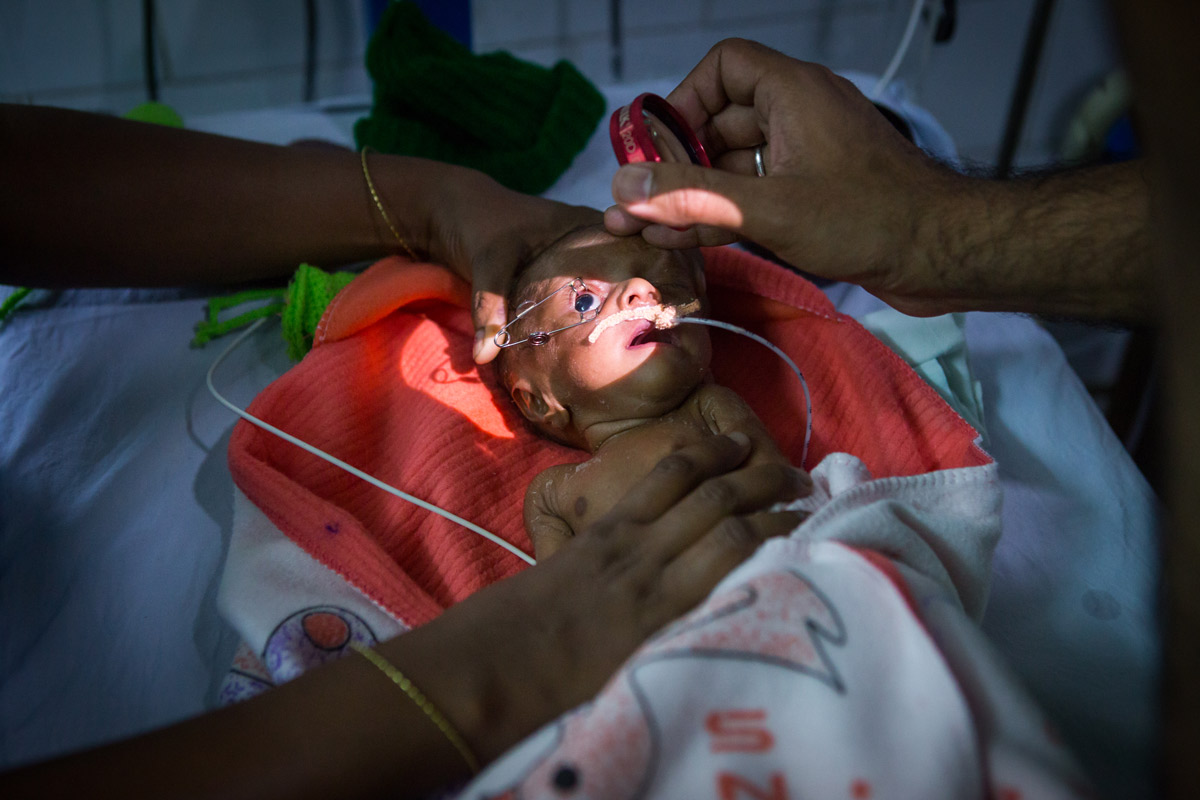
The more preterm the baby, the greater the risk of ROP
FAQs
ROP is not present at birth but starts to develop a few weeks after birth. Although ROP is more common in preterm babies who have been sick, it can also develop in babies who have not had many problems and are doing well. If the neonatologist or pediatrician has said that your baby needs to be examined for ROP then it is important that you follow this advice. In many babies only one examination is needed and the eye doctor can give you the all clear. Other babies need several examinations and only a few develop severe ROP which needs treatment.
In ROP the changes are inside the eye and are not visible from the outside – the eyes appear entirely normal. Special equipment is needed to see inside the eye.
Babies who are born up to four weeks preterm are at minimal risk of ROP and so are not usually examined. Babies who are more than four weeks premature are at risk, and the more preterm the baby the greater the risk. Most countries have guidelines on which babies need to be examined, which usually includes how preterm the baby was and how much they weighed at birth. Some countries also include whether the baby has been sick or needed a lot of oxygen.
The reason why regular eye examination starting a few weeks after birth is so important is because if severe ROP is not detected and treated it can lead to loss of vision. Once vision has been lost little can be done to improve it. Timely screening, starting 25-30 days after birth is, therefore, extremely important.
Treatment is only needed for the severe forms of ROP, which only develop in a few babies. Treatment needs to be given by an experienced ophthalmologist (eye doctor) within two-to-three days of diagnosis. The commonest form of treatment is laser, which is a special type of bright light. Sometimes the other type of treatment is needed, which entails an injection of a special medication called AntiVEGF.
If your baby needs treatment the ophthalmologist will explain which type of treatment would be best for your baby, and where the treatment will be given. If your baby is still an inpatient on the neonatal unit, the treatment is likely to take place in the neonatal unit. If your baby has already been discharged from the unit, the ophthalmologist will tell you where the treatment will be performed, which is likely to be in the eye department or hospital.
It is important that you contact the neonatologist or pediatrician in the neonatal unit and ask them when the ophthalmologist will next visit the unit. This should be done as soon as possible.
After laser treatment, the ophthalmologist who did the treatment will need to examine your baby within two weeks to make sure that the treatment is effective. Sometimes further treatment (laser or an injection) is needed. Regular follow up after laser treatment is also very important, as there is a risk that your baby may become short-sighted. If this happens they will need to wear spectacles to ensure that they can see clearly. Other eye conditions, which are less common after laser treatment for ROP, include squint and cataract, both of which can be treated.
Once you have been told that the laser treatment has been effective, your baby should be examined again at six months of age by an experienced ophthalmologist, preferably one with expertise in children’s eye conditions (paediatric ophthalmologist). How often your child is examined after that will depend on whether the ophthalmologist finds any problems, but an annual examination by a paediatric ophthalmologist during the pre-school-age years is highly recommended.
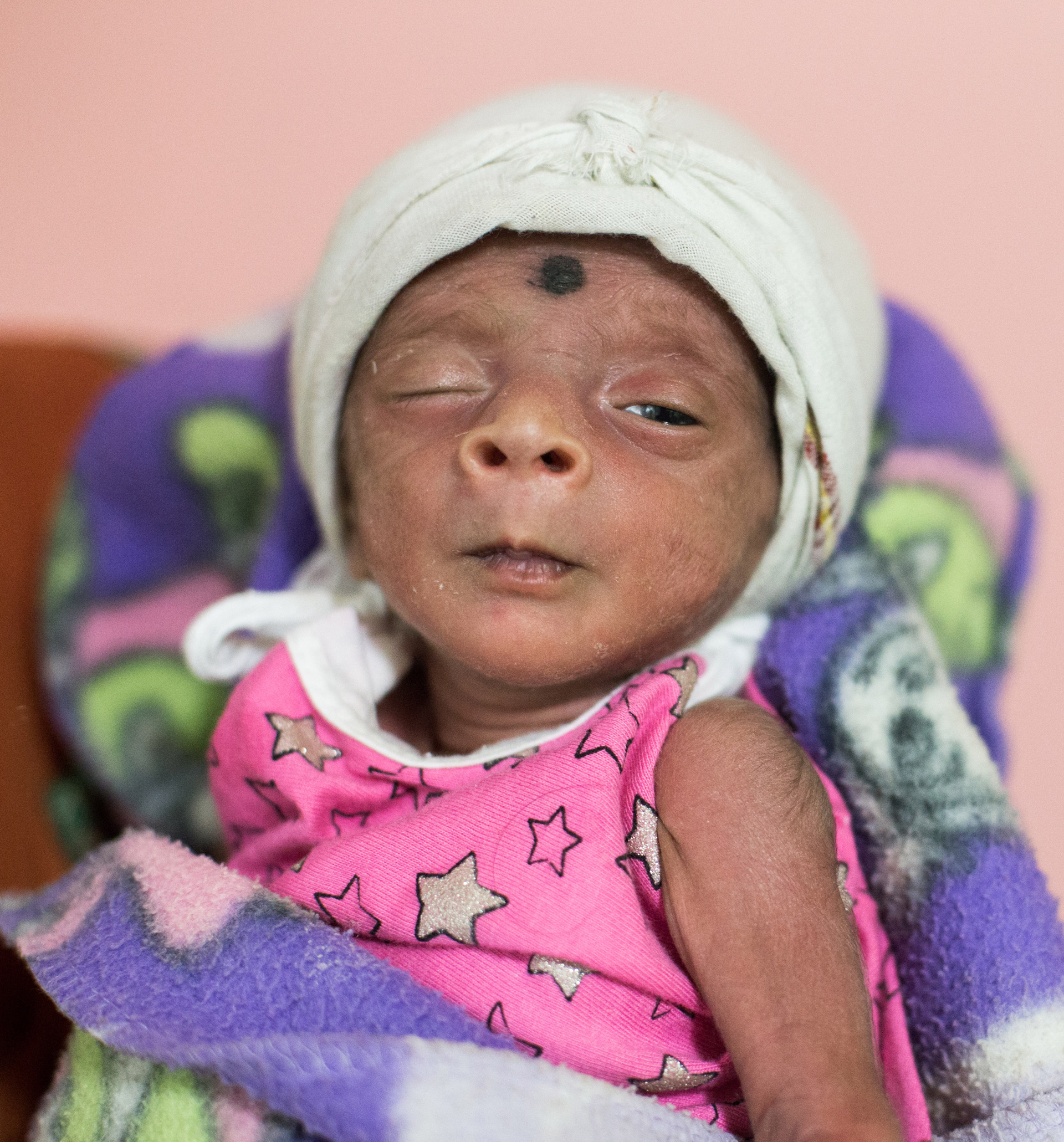
In ROP, the changes are inside the eye and are not visible from the outside
Management of ROP
There are five components to preventing loss of vision from ROP:
- Giving mothers who are about to give birth early a course of steroids
- High-quality neonatal care from immediately after birth
- Examination to detect infants with the severe stages of ROP
- Urgent treatment of the eyes of babies with severe ROP, which is highly effective at preserving vision
- Long-term follow up to look for and treat other eye complications

All preterm babies’ eyes must be examined to detect ROP
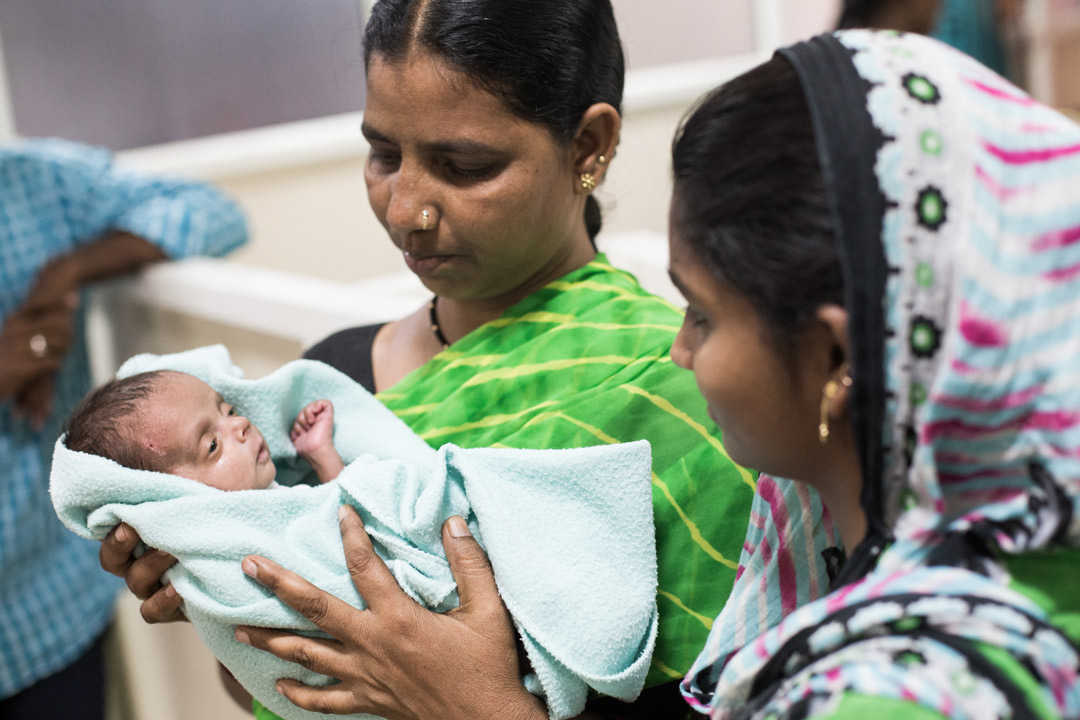
Long-term follow up is important to look for and treat other eye complications
A course of steroids given to mothers who go into labour early is very effective in preventing or reducing the seriousness of several of the complications of preterm birth, including ROP.
High-quality neonatal care requires enough nurses and doctors who are properly trained and have all the equipment they need to provide high-quality care. Parents can also help in the care of their infant, by supplying human milk, which is good for growth and health, and by providing kangaroo mother care, which entails skin-to-skin nursing of the baby against the chest. Good hygiene practices, such as hand washing and not putting toys next to the baby, can also help to reduce infection.
Preterm babies need to be examined a few weeks after birth (usually within 25-30 days) to see whether they have any ROP, and if so, how severe it is. Several examinations may be required at weekly or two-weekly intervals. The examination is usually undertaken by a trained eye doctor (ophthalmologist) who comes to the neonatal unit to examine babies while they are still an inpatient. Further examinations may be required after discharge. Sometimes a special camera is used for the examination.
If severe ROP is detected, urgent treatment is needed, within 24-72 hours. The treatment most frequently used is laser, which is given by a skilled ophthalmologist. Sometimes other treatments are needed, which entail an injection into the eye(s).
Whichever treatment is given, follow up is very important to make sure that the treatment has been successful and the ROP is going away. The treatment can be repeated, if needed.
All babies who have been treated for ROP need long-term follow up by an ophthalmologist. This is to make sure that the infant’s vision is developing, and to detect and manage complications such as short-sightedness and squint which are more common after treatment for ROP. The ophthalmologist will decide how often and where the young child needs to be examined.
- 1. Antenatal Steroids
A course of steroids given to mothers who go into labour early is very effective in preventing or reducing the seriousness of several of the complications of preterm birth, including ROP.
- 2. High-Quality Neonatal Care
High-quality neonatal care requires enough nurses and doctors who are properly trained and have all the equipment they need to provide high-quality care. Parents can also help in the care of their infant, by supplying human milk, which is good for growth and health, and by providing kangaroo mother care, which entails skin-to-skin nursing of the baby against the chest. Good hygiene practices, such as hand washing and not putting toys next to the baby, can also help to reduce infection.
- 3. Examination for ROP
Preterm babies need to be examined a few weeks after birth (usually within 25-30 days) to see whether they have any ROP, and if so, how severe it is. Several examinations may be required at weekly or two-weekly intervals. The examination is usually undertaken by a trained eye doctor (ophthalmologist) who comes to the neonatal unit to examine babies while they are still an inpatient. Further examinations may be required after discharge. Sometimes a special camera is used for the examination.
- 4. Treatment of Severe ROP
If severe ROP is detected, urgent treatment is needed, within 24-72 hours. The treatment most frequently used is laser, which is given by a skilled ophthalmologist. Sometimes other treatments are needed, which entail an injection into the eye(s).
Whichever treatment is given, follow up is very important to make sure that the treatment has been successful and the ROP is going away. The treatment can be repeated, if needed.
- 5. Long-Term Follow up
All babies who have been treated for ROP need long-term follow up by an ophthalmologist. This is to make sure that the infant’s vision is developing, and to detect and manage complications such as short-sightedness and squint which are more common after treatment for ROP. The ophthalmologist will decide how often and where the young child needs to be examined.
Useful Links to know more about ROP
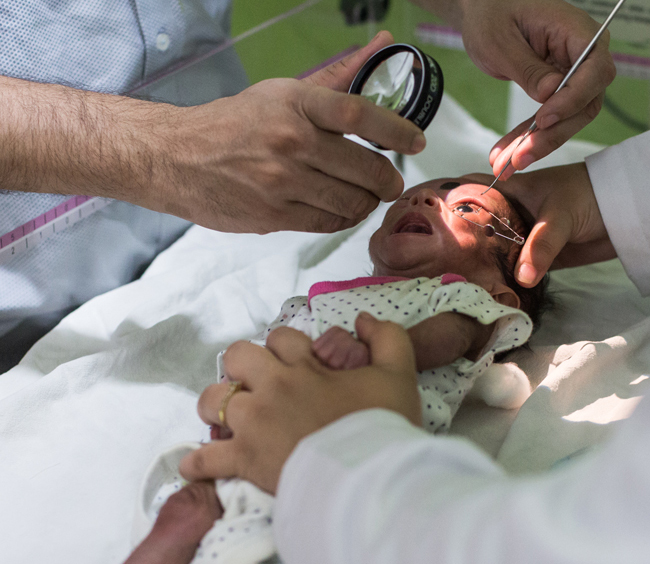
ROP screening in progress at Niloufer Hospital, Hyderabad, India
Institutions Providing ROP Services under the Project
| Name of Institute | Address | Contact |
|---|---|---|
| Shyam Shah Med College (SSMC) | Rewa, MP | 07662-241655 |
| Post Graduate Institute of Medical Education and Research (PGIMER) | Sector 12, Chandigarh, 160012 | 0172 274 7585 |
| Ujjain DH | Shrimant Maharaja, Agar Rd, Madhavrav Campus, Malipura, Ujjain, Madhya Pradesh 456006 | 0734 255 1077 |
| Sehore DH | Sewan River Square, Sehore, Madhya Pradesh 466001 | 087935 74344 |
| Dhar DH | 47, Dhar Rd, Sector A, Gujrati Colony, Indore, Madhya Pradesh 452002 | 0731 - 2382230, 2382886 |
| Kasturba Gandhi Medical College | Sultania Rd Near Hamidia Hospital, Royal Market, Bhopal, Madhya Pradesh 462001 | 0755 254 0590 |
| Name of Institute | Address | Contact |
|---|---|---|
| SCB Medical College | SCB Medical College, PG Hostel, Cuttack, Odisha 753001 | 0671- 2414355 |
| Capital Hospital (Govt.) | Udyan Marg, Unit 6, Ganga Nagar, Bhubaneswar, Odisha 751020 | 0674 239 1983 |
| LV Prasad Eye Hospital | Mithu Tulsi Chanrai Campus, Patia Rd, Bhubaneswar, Odisha 751024 | 0674 398 7999 |
| SVPPGIP, Shishubhavan | Ring Rd, Chandini Chowk, Cuttack, Odisha 753002 | 094382 61926 |
| Khurda DH | 167/1 , Hospital Road , Khordha - 752055 | 6755 220187 |
| MKCG Medical College | Medical College Campus National Highway 59, Brahmapur, Odisha 760004 | 0680 229 2746 |
| Balasore DH | Hospital Rd, Manikhamb, Balasore, Odisha 756001 | 094375 65916 |
| Mayurbhanj DH (Medical College) | Mayurbhanj, Deulasahi, Bhanjpur, Baripada, Odisha 757107 | 06792-252678 |
| Name of Institute | Address | Contact |
|---|---|---|
| Aundh DH (Pune Civil hospital) | Sanghvi Phata | 020 2970 0041 |
| HV Desai Eye Hospital | 93, Katraj-Hadapsar Bypass Rd, Tarawade Vasti, Mohammed Wadi, Pune, Maharashtra 411060 | 020 3011 4000 |
| KEM Hospital | 489, Sardar Moodliar Road, Rasta Peth, Pune, Maharashtra 411011 | 020 6603 7300 |
| Nashik DH | Trambakeshwar Road, Police Staff Colony, Nashik, Maharashtra 422002 | 0253 257 6106 |
| Osmanabad DH | Niramay Hospital, Shivram Wada, S.R.T.Colony, Osmanabad, Maharashtra 413501 | 02472 227 005 |
| Thane DH | Shankar Rao Pednekar Road, Opposite Police Quarter, Tembhi Naka,Thane, Maharashtra 400601 | 022 2547 2582 |
| Nagpur DH | Flat No 302, Shrikrishna Apartment, Near Sadhna Sahakari Bank, Jaripatka, Nagpur, Maharashtra 440014 | 0712 264 5400 |
| Name of Institute | Address | Contact |
|---|---|---|
| Niloufer Children’s Hospital | 11-4-721, Niloufer Hospital Rd, Red Hills, Lakdikapul, Hyderabad, Telangana 500004 | 040 2331 4095 |
| LV Prasad Eye Hospital | Kallam Anji Reddy Campus, LV Prasad Marg, Opp. PVR, Park View Enclave, Banjara Hills, Hyderabad, Telangana 500034 | 040 3989 2020 |
| Nalgonda DH | Rahamath Nagar, Ramgiri, Nalgonda, Telangana 508003 | 086822 23899 |
| Gandhi Medical College & Hospital | Bhoiguda Road, M.I.G.H colony, Musheerabad, Walker Town, Padmarao Nagar, Secunderabad, Telangana 500025 | 040 2750 5566 |
| Sangareddy DH | Opp police station, Dist,, Sangareddy, Telangana | 9000269555 |
| Pushpagiri Vitreo-Retinal Institute | Plot No 241, Uma Plaza, 9, West Marredpally, Secunderabad, Telangana 500026 | 040 2780 4949 |
- Madhya Pradesh
Name of Institute Address Contact Shyam Shah Med College (SSMC) Rewa, MP 07662-241655 Post Graduate Institute of Medical Education and Research (PGIMER) Sector 12, Chandigarh, 160012 0172 274 7585 Ujjain DH Shrimant Maharaja, Agar Rd, Madhavrav Campus, Malipura, Ujjain, Madhya Pradesh 456006 0734 255 1077 Sehore DH Sewan River Square, Sehore, Madhya Pradesh 466001 087935 74344 Dhar DH 47, Dhar Rd, Sector A, Gujrati Colony, Indore, Madhya Pradesh 452002 0731 - 2382230, 2382886 Kasturba Gandhi Medical College Sultania Rd Near Hamidia Hospital, Royal Market, Bhopal, Madhya Pradesh 462001 0755 254 0590 - Odisha
Name of Institute Address Contact SCB Medical College SCB Medical College, PG Hostel, Cuttack, Odisha 753001 0671- 2414355 Capital Hospital (Govt.) Udyan Marg, Unit 6, Ganga Nagar, Bhubaneswar, Odisha 751020 0674 239 1983 LV Prasad Eye Hospital Mithu Tulsi Chanrai Campus, Patia Rd, Bhubaneswar, Odisha 751024 0674 398 7999 SVPPGIP, Shishubhavan Ring Rd, Chandini Chowk, Cuttack, Odisha 753002 094382 61926 Khurda DH 167/1 , Hospital Road , Khordha - 752055 6755 220187 MKCG Medical College Medical College Campus National Highway 59, Brahmapur, Odisha 760004 0680 229 2746 Balasore DH Hospital Rd, Manikhamb, Balasore, Odisha 756001 094375 65916 Mayurbhanj DH (Medical College) Mayurbhanj, Deulasahi, Bhanjpur, Baripada, Odisha 757107 06792-252678 - Maharashtra
Name of Institute Address Contact Aundh DH (Pune Civil hospital) Sanghvi Phata 020 2970 0041 HV Desai Eye Hospital 93, Katraj-Hadapsar Bypass Rd, Tarawade Vasti, Mohammed Wadi, Pune, Maharashtra 411060 020 3011 4000 KEM Hospital 489, Sardar Moodliar Road, Rasta Peth, Pune, Maharashtra 411011 020 6603 7300 Nashik DH Trambakeshwar Road, Police Staff Colony, Nashik, Maharashtra 422002 0253 257 6106 Osmanabad DH Niramay Hospital, Shivram Wada, S.R.T.Colony, Osmanabad, Maharashtra 413501 02472 227 005 Thane DH Shankar Rao Pednekar Road, Opposite Police Quarter, Tembhi Naka,Thane, Maharashtra 400601 022 2547 2582 Nagpur DH Flat No 302, Shrikrishna Apartment, Near Sadhna Sahakari Bank, Jaripatka, Nagpur, Maharashtra 440014 0712 264 5400 - Telangana
Name of Institute Address Contact Niloufer Children’s Hospital 11-4-721, Niloufer Hospital Rd, Red Hills, Lakdikapul, Hyderabad, Telangana 500004 040 2331 4095 LV Prasad Eye Hospital Kallam Anji Reddy Campus, LV Prasad Marg, Opp. PVR, Park View Enclave, Banjara Hills, Hyderabad, Telangana 500034 040 3989 2020 Nalgonda DH Rahamath Nagar, Ramgiri, Nalgonda, Telangana 508003 086822 23899 Gandhi Medical College & Hospital Bhoiguda Road, M.I.G.H colony, Musheerabad, Walker Town, Padmarao Nagar, Secunderabad, Telangana 500025 040 2750 5566 Sangareddy DH Opp police station, Dist,, Sangareddy, Telangana 9000269555 Pushpagiri Vitreo-Retinal Institute Plot No 241, Uma Plaza, 9, West Marredpally, Secunderabad, Telangana 500026 040 2780 4949




